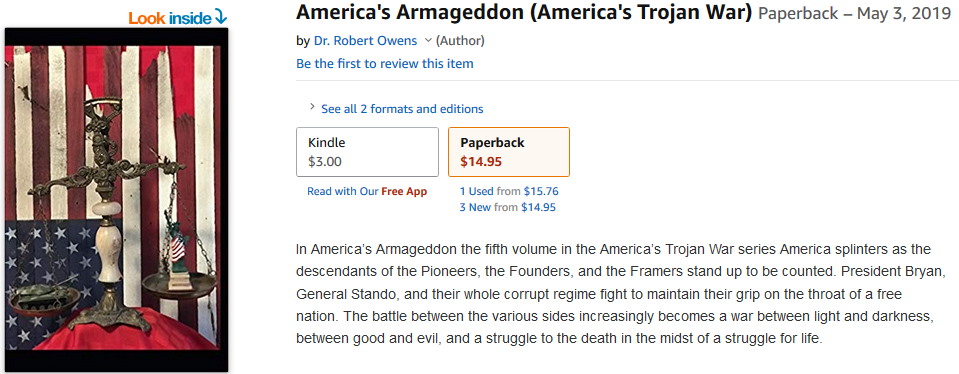What’s All This “In” Christ Business About?
- Written by Dr. Robert Owens

Sometimes we born-again believers talk in such a closed-circuit Christianese dialect that baby believers, old line denominational members, let alone your everyday garden variety sinner has no idea what we’re talking about. We throw around words that carry massive meaning to us but sound like in-crowd jargon to those hearing them from the outside.
Propitiation, justification, and salvation are all words that trip up nonbelievers as they tiptoe around the cross. Then there are phrases we think say it all that leave those we want to reach scratching their heads and standing off instead of kneeling down. Phrases such as: substitutionary death, pleading the blood, I’m born-again, I’m Filled with the Holy Ghost, and here’s one that throws them all, in Christ.
A dictionary will help with the words. The phrases usually take a little time in fellowship with others to sort out and understand. I can’t try to explain them all here, but I will try to address one of the most cryptic phrases to the uninitiated, in Christ.
“In Him.” This is a major theme of Paul’s letter to the Ephesians and of the whole New Testament. It’s a central teaching and a foundational truth. If for some reason this sounds strange to your ears or is a new concept study to show yourself approved. We should follow the example of some early believers who upon hearing the Gospel of Jesus Christ, “searched the Scriptures daily to find out whether these things were so.”
We can’t allow our development as believers to be the responsibility of anyone else. Yes, it’s good and advisable to have teachers and mentors; however, we can’t rely on them alone. In his letter to the Philippians Paul told them to “work out your own salvation with fear and trembling” and this is advice that we should also take to heart.
This major theme echoes through the New Testament: we are “in” Christ. Thousands of years after it was first presented to humanity it continues to ricochet through this verse into our spirit. The born-again believer resonates like a tuning fork to this life-giving message. The message, “For God so loved the world that He gave His only begotten Son, that whoever believes in Him should not perish but have everlasting life,” floods down the corridors of time like an avalanche of hope.
The birth, life, death, and resurrection of Christ is the living parable of love for all to see.
The birth of Jesus set forth in scripture, is a graphic portrayal of prophecy fulfilled. The Incarnation is the union of deity and humanity. It was divine love’s invasion into the realm of human selfishness. That which had been foretold for millennia finally arrived. Or as the author of Hebrews tells us, “God, who at various times and in various ways spoke in time past to the fathers by the prophets, has in these last days spoken to us by His Son, whom He has appointed heir of all things, through whom also He made the worlds.”
This invasion wasn’t by an army of angels though it could’ve been. It wasn’t by raising up Israel to conquer the world and imposing belief in the One True God by force though that could’ve happened. Instead this invasion took the form of a tiny, defenseless Baby born in a manger on the poor side of town.
His parents called Him Jesus and His name has filled hearts and souls of humanity with songs and praise ever since. The love brought by God through this one birth has given hope to the defeated, healing to the sick, liberty to those in bondage, and salvation to all who confess Him as Lord and believe in their heart that God raised Him from the dead.
All this is based upon the finished work of Christ. This finished work is the ultimate revelation of divine love. Jesus gave His life freely in place of ours. He voluntarily became sin in our place so that we could become the very righteousness of God.
And we become that righteousness when we claim our place as a part of the body of Christ, the church so that when we stand before God He doesn’t see our sins and our shortcomings, instead He sees the absolute righteousness of His own Son. This is how we can stand before a holy God with no sense of shame, guilt, or inadequacy.
The New Testament describes this well, “The way God designed our bodies is a model for understanding our lives together as a church: every part dependent on every other part, the parts we mention and the parts we don’t, the parts we see and the parts we don’t. If one-part hurts, every other part is involved in the hurt, and in the healing. If one-part flourishes, every other part enters into the exuberance. You are Christ’s body—that’s who you are! You must never forget this. Only as you accept your part of that body does your “part” mean anything.”
And this is what we mean by being “in” Christ. We have accepted our place as a member, or part of Christ’s mystical body: the church. It is no longer we who live but Christ lives in us and through us. And now that we know, let’s go forth and be all that God has called us to be, let’s allow Christ to live in us as we live in Him. Let’s allow Him to reach through us and minister to a world in need.
Dr. Owens teaches History, Political Science, Global Studies, and Religion. He is the Historian of the Future @ http://drrobertowens.com © 2020 Contact Dr. Owens drrobertowens@hotmail.com Follow Dr. Robert Owens on Facebook or Twitter @ Drrobertowens or visit Dr. Owens Amazon Page / Edited by Dr. Rosalie Owens
Excerpt:
Things we think say it all that leave those we want to reach scratching their heads and standing off instead of kneeling down.
Tags:
Salvation, Dr. Robert Owens, propitiation, born-again, justification, filled with the Holy Ghost


